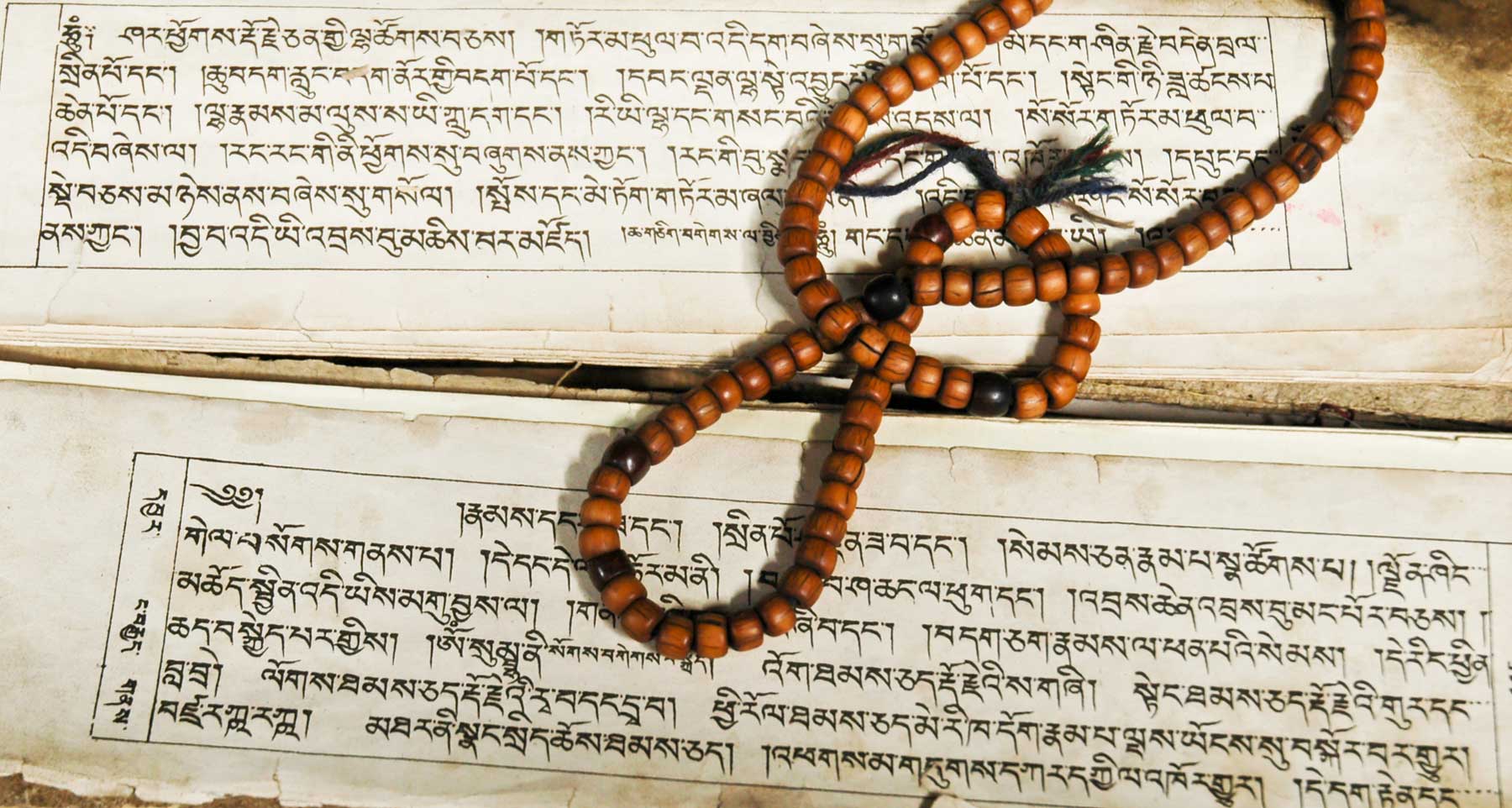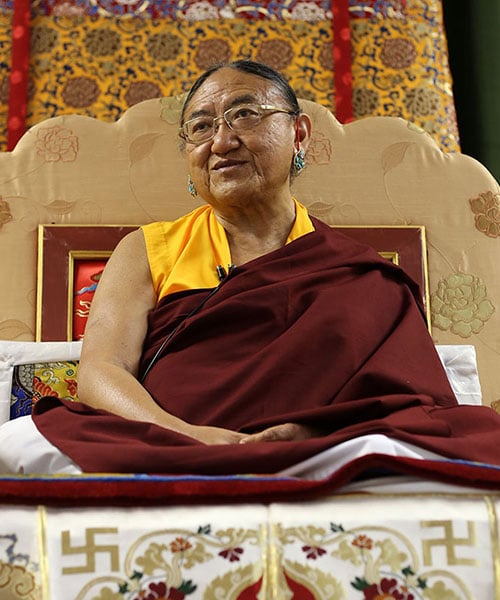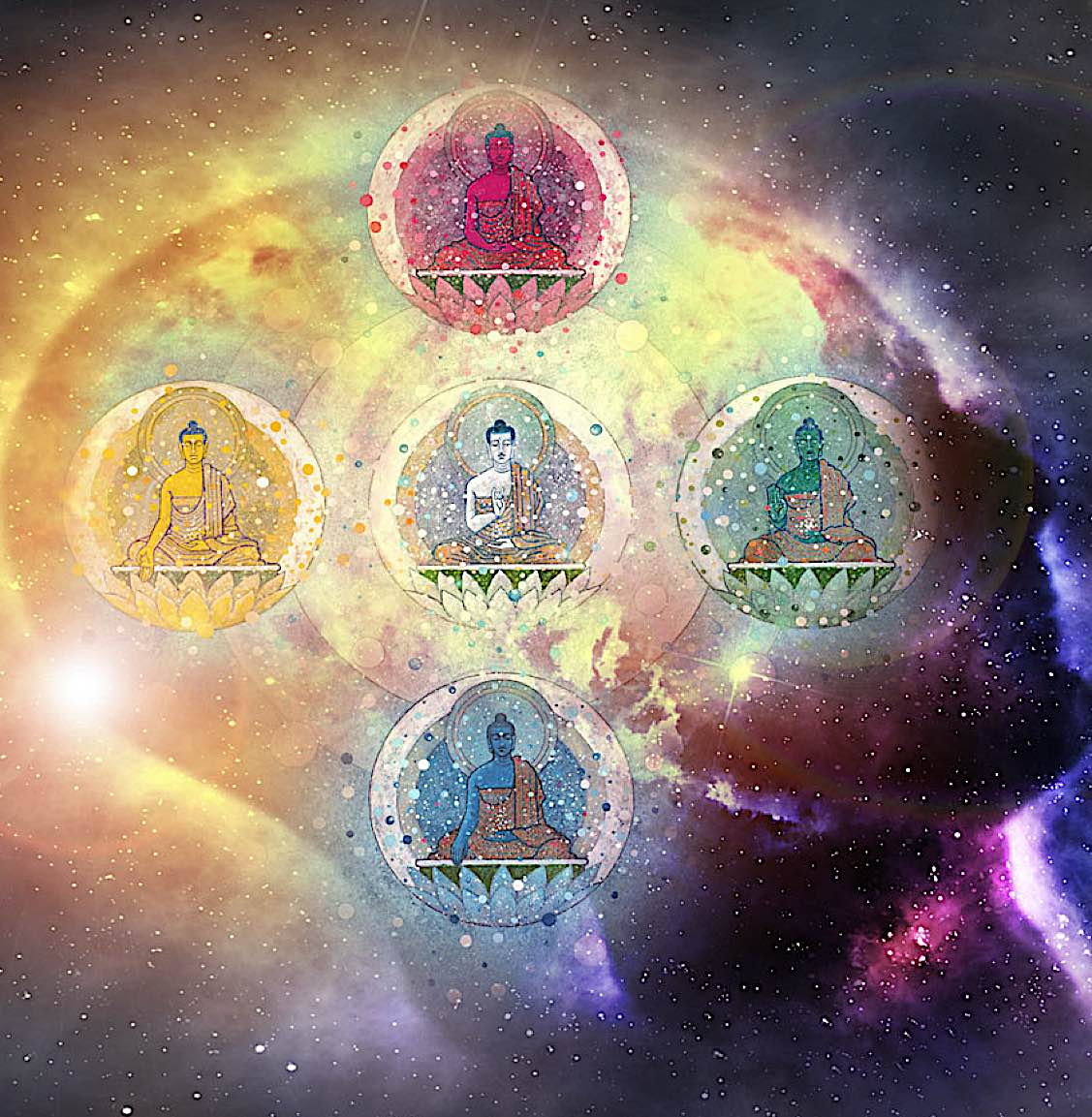Bodhisattva Vow and the Bonding Aspiration of the 5 Buddha Families: Reversing Dharma Downfalls, Purifying Karma, and Restoring Commitments
What short daily recitation practice can reverse all our negative karmas and downfalls? Why should it be recited every day, or at least on the 10th and the 25th of each lunar month? Why is the Bodhisattva Vow vitally...

 Dharmachakra (left) was a Bodhisattva monk who took 48 vows before the Buddha of his time Lokesvara. Because of these great vows, he attained full Enlightenment and become Amitabha Buddha. We take the same vows today, with the Bodhichitta aspiration to also become Enlightened so we may also help all sentient beings.
Dharmachakra (left) was a Bodhisattva monk who took 48 vows before the Buddha of his time Lokesvara. Because of these great vows, he attained full Enlightenment and become Amitabha Buddha. We take the same vows today, with the Bodhichitta aspiration to also become Enlightened so we may also help all sentient beings.
What short daily recitation practice can reverse all our negative karmas and downfalls? Why should it be recited every day, or at least on the 10th and the 25th of each lunar month? Why is the Bodhisattva Vow vitally important to reversing downfalls and purifying? Why are the five bonding aspirations of the 5 Buddhas Families so empowering? We answer these questions, and end with a beautiful, short recitation of the Concise Bodhisattva Vow and 5 Bonding Vows which purifies all negative karma and downfalls.
 Ideally, for purification practices such as Bodhisattva Vows, stand in front of an altar with images of the Three Jewels: Buddha Dharma and Sangha. If there is no altar, simply visualize the three jewels in front of you.
Ideally, for purification practices such as Bodhisattva Vows, stand in front of an altar with images of the Three Jewels: Buddha Dharma and Sangha. If there is no altar, simply visualize the three jewels in front of you.
Three Daily Recitations Purifies all Downfalls
Three short daily practices help us purify our negative downfalls and karmas daily. These recitations are encouraged for most Buddhists, and required for those who have taken the commitments. The first, Refuge in the Three Jewels, is for all Buddhists. The second, the Bodhisattva commitment and vow to help all beings, is a must for Mahayana Buddhists of the Great Vehicle. The third, the 5 Bonding Vows of the 5 Buddha Families is for most Vajrayana Buddhists, and necessary for anyone with Higher Initiations.
Together, and separately, these three very short daily recitations, purify all our downfalls and negative karmas and remove our obstacles, both external and internal, and renew our aspiration. They are normally recited aloud, in a short format.
 Ideally make your vows in front of an altar, but if you are not near any shrine, your mala substitutes for all three. The beads of the mala represent the Sangha, the larger bead (guru bead) represents the Buddha, and the entire mala represents Dharma Speech. Likewise, a Sutra or Practice text can be considered substitution for all three jewels. Or, simply visualize the Buddha, Dharma and Sangha in front of you when you make your vows.
Ideally make your vows in front of an altar, but if you are not near any shrine, your mala substitutes for all three. The beads of the mala represent the Sangha, the larger bead (guru bead) represents the Buddha, and the entire mala represents Dharma Speech. Likewise, a Sutra or Practice text can be considered substitution for all three jewels. Or, simply visualize the Buddha, Dharma and Sangha in front of you when you make your vows.
1 – Refuge in the Three Jewels
The first is Taking Refuge in the Three Jewels. It is a daily practice for every Buddhist. It re-affirms that our sole Refuge is the Enlightened Buddha, the Buddha’s Dharma Teachings, and the Community of Buddhists.
 Prostration to the Three Jewels (either physically or mentally) begins all Buddhist practices.
Prostration to the Three Jewels (either physically or mentally) begins all Buddhist practices.
2- Bodhisattva Vow
The Bodhisattva vow, is the vow that defines what it means to be a Mahayana Buddhist — a Buddhist who aspires to Enlightenment for the benefit of all sentient beings. It is the most important of all practices.
It is through the methods described in the vow that we can accomplish the goal as a Bodhisattva, of attaining Enlightenment for the benefit of all sentient beings. Even if we don’t state the vow in our daily practice, we at least practice the seven practices of a Bodhisattva. To ensure we avoid downfalls and negative karma, we make and live this vow.
 All Buddhas of all times became Buddhas through the Bodhichitta aspiration — and the Bodhisattva path and vows. In this image, the Bodhisattva Avalokiteshvara, who is the shining symbol of the Enlightened Bodhisattva.
All Buddhas of all times became Buddhas through the Bodhichitta aspiration — and the Bodhisattva path and vows. In this image, the Bodhisattva Avalokiteshvara, who is the shining symbol of the Enlightened Bodhisattva.
3 – 5 Bonding Vows of the 5 Buddha Families
For serious practitioners of the Lightning path of Vajrayana, we also purify these downfalls and negative karmas with the 5 Bonding Vows to the 5 Buddha Families. In making this statement daily — or at least twice a month on the 10th and 15 of the lunar month — we remind ourselves of the method to accomplish Enlightenment. The 5 Bonding Vows are almost a “how-to” or a reminder of what we should be doing each day. Regardless of the Buddha or Yidam you personally practice, we always remain mindful of all five Buddha Families and what they mean.
None of these require initiation — but if you have initiations, they are mandatory. If you don’t they are beautiful aspirational practices that purify our karma and remove our obstacles.
 His Holiness the Sakya Trichen offered several grand empowerment events for Saga Dawa online, freely accessible. These empowerments symbolize and manifest our aspiration to become Enlightened for the benefit of all sentient beings.
His Holiness the Sakya Trichen offered several grand empowerment events for Saga Dawa online, freely accessible. These empowerments symbolize and manifest our aspiration to become Enlightened for the benefit of all sentient beings.
When you take an initiation, this will be the vows you recite with the teacher, although they will be a longer form, and they might be recited in Sanskrit, Tibetan, or other languages. You can add your name, to personalize it if you wish, either your birth name, or likely your Dharma name if you have one.
If you don’t have initiation, this is still a beautiful empowering and purifying practice.
 When we take our vows, and renew them daily as the Five Buddha Family vows and the Bodhisattva Vows, we visualize the Buddhas, the entire merit field, and our gurus in front of us. In picture is His Eminence Garchen Rinpoche. Inset corner is Ushnisha Vijaya (image from an event on Ushnisha Vijaya). In the background are hundreds of Buddha Statues and offerings in front of them. His Eminence holds a prayer wheel containing millions of mantras, which is famously spins at all his events, to send out compassionate mantras to all beings.
When we take our vows, and renew them daily as the Five Buddha Family vows and the Bodhisattva Vows, we visualize the Buddhas, the entire merit field, and our gurus in front of us. In picture is His Eminence Garchen Rinpoche. Inset corner is Ushnisha Vijaya (image from an event on Ushnisha Vijaya). In the background are hundreds of Buddha Statues and offerings in front of them. His Eminence holds a prayer wheel containing millions of mantras, which is famously spins at all his events, to send out compassionate mantras to all beings.
Promising in Front of the Three Jewels
You are making this aspiration in front of the Three Jewels, whether you have an altar or not. You imagine they arise in front of you. If you have a Guru or teacher, you are also making the promise in front of your teacher, even if your teacher is far away.
Four Rs of Purification
These three practices also represent the four Rs of purification, which are respectively: regret, reliance, remedy and resolve.
Rely in our Refuge
First, is Rely. Our Refuge is our “reliance practice.” We rely on the Three Jewels of Buddha, Dharma and Sangha.
Regret – Confession
Second, the Regret, which is the statement of confession. We are making this statement in front of the Three Jewels, which helps us purify negative karma. Part of the confession is also a “promise to refrain” from these downfalls in future.
Remedy – Bodhisattva Vow
The third R is Remedy. The Remedy is the Bodhisattva Vow. This purifies all karmas and downfalls.
One method of practicing the FOUR Rs is Vajrasattva practice. While holding in mind the four Rs of Rely, Regred, Remedy and Resolve we chant the powerful purifying mantra of Vajrasattva in Sanskrit:
Resolve – The Bonding Vows to the 5 Buddhas
The fourth R is Resolve. The 5 Bonding promises to the 5 Buddha Families is the Resolve Practice. Through this aspiration we not only progress positively towards accomplishments, but we remind ourselves of every step. We resolve to be perfect in our practice. In the beginning, we will not be, but like a mantra, we repeat this daily, so that we always have the promises in the top of our mind. Although the vow mentions the Buddha of each family, the vow is before the entire family, and especially the father Buddhs and mother Buddhas:
 Five Dhyani Buddhas. The Five Aspirations are made to the Five Buddhas who accomplished in their past lives and became Buddhas. For example, Amitabha (second from right, red) is the Buddha who became Enlightened from his previous vows (48 vows). (In Buddhist cosmology, there are endless aeons or cycles of time, very much in keeping with what we know of the Universe. In each Aeon there were different Buddhas who now remain in their Purelands to help us: Amitabha (red) in the West Pureland, Amoghasiddhi (green) in the North Pureland, Akshobhya (blue) in the East Pureland, Ratnsasambhava (yellow) in the Southern Pureland, Vairochana (white) in the Centre Pureland. They became Enlightened with their great Vows. With the FIVE ASPIRATION VOWS we likewise vow to become Enlightened through the conduct of the five Buddhas.
Five Dhyani Buddhas. The Five Aspirations are made to the Five Buddhas who accomplished in their past lives and became Buddhas. For example, Amitabha (second from right, red) is the Buddha who became Enlightened from his previous vows (48 vows). (In Buddhist cosmology, there are endless aeons or cycles of time, very much in keeping with what we know of the Universe. In each Aeon there were different Buddhas who now remain in their Purelands to help us: Amitabha (red) in the West Pureland, Amoghasiddhi (green) in the North Pureland, Akshobhya (blue) in the East Pureland, Ratnsasambhava (yellow) in the Southern Pureland, Vairochana (white) in the Centre Pureland. They became Enlightened with their great Vows. With the FIVE ASPIRATION VOWS we likewise vow to become Enlightened through the conduct of the five Buddhas.The Five Mothers
When we make the five vows, we are equally making the vows to the Five Mothers: Tara, The Five Mothers are the co-equals — often called consorts, but more properly called Prajna Wisdom Mothers:
Mamaki in the south Red Paṇḍāravāsinī in the West Blue Locana in the East Green Tara in the North White Tara or Ākāśadhātvīśvarī in the CenterIn Mahayana Buddhism, the Female Buddhas represent Perfect Wisdom and are indispensable. In Buddhism, the Female Buddhas sybmolize Perfect Wisdom while the Male Buddhas Represent Perfect Compassion. Both are co-equal partners as methods in Mahayana Buddhism. What is often misunderstood is the concept that even if you practice a single Buddha, for example, Amitabha, he is never separate from his Female Co-Equal Buddha Pandara. Or, if you practice Green Tara as a sole practice, she is never separate from her co-Equal Male Budddha Amoghasiddhi. These are forms, manifesting to help us according to our own preferences and needs.
 Five Dhyani Prajna Wisdom Female Buddhas from left to right Yellow
Five Dhyani Prajna Wisdom Female Buddhas from left to right YellowMamaki in the south, Red Paṇḍāravāsinī in the West, Blue Locana in the East, Green Tara in the North and White Tara or Ākāśadhātvīśvarī in the Center. In some mandalas, for specific practices, the Center and East are switched, with White Tara in the East and Locana in the Center. Beautiful artwork from Laura Santi of Laura Santi Sacred Art.
The 5 Aspirations and Vows
The Five Aspirations are to each of the Five Buddha Families, who represent all Buddhas and Bodhisattvas and Mothers of all times. In Buddhism, the five families represent a Mandala, or map of the Universe. These each represent five wisdoms which overcome the five poisons of ignorance, anger, pride, attachment and jealousy. By taking the aspirational vow, we are basically stating we aspire to eliminate all five poisons and attain the five wisdoms.
The Centre family in the mandala is the Buddha Family of Vairochana Buddha and Akasha Dhatvishvara who purify Ignorance with the Wisdom of Dharmadatu. The East is the Vajra family of Akshobhya Buddha and Lochana who overcome anger with Mirror-like wisdom. The South is the Jewel Family of Ratnasambhava and Mamaki, who overcome Pride with the wisdom of equality. The West is the Lotus family of Amitabha and Pandaravashini, who subdue attachments with the wisdom of Discernment. Finally, in the North is the important Activity or Karma family of Amoghasiddhi and Green Tara, who use All-Accomplishing Wisdom to overcome the poison of envy or jealousy.With the vow, we state the supporting practices. For example, the vow to the Jewel family is to practice the four generosities.
 A mandala can be thought of as a map for the mind to explore. This is the Mandala of the Five Buddhas: Top red (west) Amitabha, Centre (white) Vairochana, right (green) Amoghasiddhi, bottom (blue) Akshobhya, left (yellow) Ratnasambhava. In some lineages, Vairochana and Akshobhya switch places (due to the visualizations of that lineage teaching, but generally this is the direction of the Purelands and the Buddha Families.
A mandala can be thought of as a map for the mind to explore. This is the Mandala of the Five Buddhas: Top red (west) Amitabha, Centre (white) Vairochana, right (green) Amoghasiddhi, bottom (blue) Akshobhya, left (yellow) Ratnasambhava. In some lineages, Vairochana and Akshobhya switch places (due to the visualizations of that lineage teaching, but generally this is the direction of the Purelands and the Buddha Families.
Recitation Text: 3 Practices of Renewal
Either in front of an altar with images of the Three Jewels, Buddha Dharma and Sangha, or imagining them arising in front of you, we begin recitation. Symbols on al altar for the three Jewels is usually
A Dharma Text (or printed text) — this is often a Sutra, or the Meditational Text you focus on in practice. This represents the Enlightened Speech of the Buddha, and should be the “highest” on the altar, even higher than the statue. This is why in Tibetan Sutras you see the books higher than the statues. If you have a Stupa on your altar (a statue of a stupa or image) this represents the Body of the Buddha. (If you do not have a Stupa, your Buddha statue or image represents all Three Jewels). A statue or picture of Buddha — or the Enlightened Buddha form you practice in your tradition. This represents the Enlightened Sangha and the “Mind” of the Buddha. The Enlightened Sangha include all Buddhas, Bodhisattvas, Enlightened Dakas and Dakinis, Yidams, Enlightened Protectors, regardless of your personal practice and yidam. (A statue can also represent all three of Buddha, Dharma and Sangha if it is alone on your altar). Five Dhyani Prajna Wisdom Female Buddhas from left to right Yellow
Five Dhyani Prajna Wisdom Female Buddhas from left to right YellowMamaki in the south, Red Paṇḍāravāsinī in the West, Blue Locana in the East, Green Tara in the North and White Tara or Ākāśadhātvīśvarī in the Center. In some mandalas, for specific practices, the Center and East are switched, with White Tara in the East and Locana in the Center. Beautiful artwork from Laura Santi of Laura Santi Sacred Art.
If you have none of these, you imagine them in your meditation, in front of you, receiving the vows.
We start with Refuge, then the Bodhisattva Vow — which includes Refuge and the Confession of downfalls. This is an important step in purifying negative karma. Then, we recite with us, the five Bonding Promises to the 5 Buddha Families. Finally, we end with the all-important Four Immeasurables and the Bodhichitta dedication. To this, you can also add your own noble requests and aspirations.
Recitation
I take my Bodhisattva Vows and Refuge three times to Renew my Aspiration. (Optionally add your name or Dharma Name here: “I, my name, take my…” and so on. You only need your name at the beginning.
I go for refuge to the Three Jewels,
And confess each of my negative actions,
I rejoice in the virtues of migrating beings,
And hold with my mind a Buddhas’ enlightenment.
To Buddha, Dharma, and the Supreme Assembly
I go for refuge until I am enlightened,
And to accomplish the welfare of myself and others
I will generate the mind of enlightenment.
Having generated the mind of supreme enlightenment,
I shall invite all living beings to be my guest
To engage in the pleasing, supreme practices of enlightenment.
May I attain Buddhahood to benefit living beings.
I go for refuge to the Three Jewels,
And confess each of my negative actions,
I rejoice in the virtues of migrating beings,
And hold with my mind a Buddhas’ enlightenment.
To Buddha, Dharma, and the Supreme Assembly
I go for refuge until I am enlightened,
And to accomplish the welfare of myself and others
I will generate the mind of enlightenment.
Having generated the mind of supreme enlightenment,
I shall invite all living beings to be my guest
To engage in the pleasing, supreme practices of enlightenment.
May I attain Buddhahood to benefit living beings.
Now, I recite the Five Bonding Aspirations to the 5 Buddha Families, three times to empower my practice.
day onward, the vows arisen from the Buddha Family.
The unsurpassed Three Jewels of the Buddha, Dharma and Sangha.
I shall uphold purely the vajra, bell and mudra of the great, supreme Vajra family, and I shall uphold purely the Master commitment.
I will always make the four types of gifts six times each day; the pleasing commitments of the great supreme Jewel family.
For the pure, great Lotus family, arisen from great enlightenment, I shall uphold each of the holy Dharmas, of the outer, the secret and the three vehicles.
For the great, supreme Action family, I shall uphold purely each of vows I am endowed with, and make as many offering as I am able.
I shall generate the holy, unsurpassed Bodhichitta, and for the welfare of all living beings, I shall uphold all of my aspirations without exception.
I shall liberate those not liberated, deliver those not delivered, give breath to those breathless, and lead all beings to nirvana.
May all beings have happiness and is causes.
May all beings be free from suffering and the causes of suffering.
May all beings constantly dwell in joy transcending sorrow.
May all beings abide in equanimity free from hatred and attachment.
Through the force of my making these praises and requests to you,
I dedicate the merit of these aspirations and vows to the cause for Enlightenment for the benefit of all sentient beings. Please pacify all sickness, poverty, misfortune, fighting and quarrelling, throughout all directions where I and others live, and cause the Dharma and all good fortune to flourish.
May all beings benefit.
References
Common Bonding Practices for the Five Buddha Families:
https://studybuddhism.com/en/advanced-studies/prayers-rituals/vows/common-bonding-practices-for-the-buddha-families

 ShanonG
ShanonG 



















![The 2026 AI Search Benchmark Every SEO Leader Needs [Webinar] via @sejournal, @lorenbaker](https://www.searchenginejournal.com/wp-content/uploads/2025/11/1-259.png)












